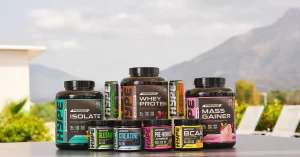What was in the works for a while has finally arrived, quietly ushered in on the fringes. As a brand constantly evolving, and after years of keeping gamers wired, dreamers dreaming, and adventurers exploring from Tehran to Brussels with our energy drinks, we’re now stepping into a new world of energy – nutrition.
It’s a natural step for us, building on years of expertise in energy, high-octane performance, and providing people with that extra kick to hack the rules.
Speaking of nutrition, let’s break down the basics, what that means for you, and how to get started.

The global dietary supplements industry is projected to grow to $351 billion by 2032. Let us repeat this for the people in the back—$ 351 billion in 8 years’ time. It’s safe to say business is booming, but with that, life gets complicated because options – both good and bad – are plenty.
It’s hard not to be tempted by the powders, protein bars, and shakes that promise to help your strength and recovery routine. Whey and creatine are among the most popular ones on the market.
But what do they actually do, and who should take them?
First off, supplements aren’t magic pills or powders. They’re called supplements for a reason – they supplement your diet, not replace it. You can’t out-supplement a bad diet, period.
You are what you eat consistently, and no amount of whey or creatine will change that.
Let’s talk about protein for a minute.
If you’re putting in work at the gym, you need fuel. We’re talking 1.4 to 2 grams of protein per kilogram of body weight daily.
For someone who weighs around 75kg, that’s 105 to 150 grams of protein daily.
Ideally, you could get that from whole foods – chicken breast, turkey, Greek yogurt, milk, chickpeas, but who’s got time to meal prep like a pro athlete when you’re juggling a 9-to-5, family and trying to maintain some resemblance of a social life?
This is where whey protein helps. It’s fast, easy, and has all nine essential amino acids your body can’t produce on its own. Gulp down a shake post-workout, and you feed those hungry muscles in minutes.
It might not replace your steak dinner, but it helps you fill the gaps when life gets in the way of your perfectly planned nutrition.
Let’s add creatine to the equation.
There’s a myth we need to bust first. Creatine doesn’t directly make your muscles grow. So why bother? Because it’s like putting premium fuel in your car. Creatine replenishes phosphocreatine, the energy currency of your muscle cells. More energy means more reps, more sets, and more gains.
However, creatine needs something to work with, so if you don’t engage in resistance or weight training, creatine won’t do much for you.
With the supplement market flooded with options, navigating this minefield requires a discerning eye. Don’t fall for fancy marketing or promises of overnight transformation. Instead, focus on quality and credibility. Look for products tested by third-party labs.
All of Hype’s (Hyperlink here) whey and creatine products have endured rigorous testing to ensure safety and peak performance.
When used correctly, supplements can transform your workout routine, but they’re not a substitute for hard work, consistency, and a solid nutritional foundation.
They’re the cherry on top of your fitness sundae, not the whole damn dessert.
If you haven’t optimized your diet and trained consistently, focus on the basics first, before you spend your money on supplements, because no supplement can outperform dedication and sweat equity.
